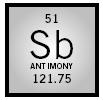Antimony

MELTING POINT:
630°C
BOILING POINT
: 1,750°C
DENSITY
: 6.684 g/cm
3
MOST COMMON IONS
: Sb
3+
, SbO
+
Antimony is a metalloid element, or a semimetal, its chemical behavior being between those of metals and nonmetals. It is a substance that was known in the ancient world. Antimony sulfide was used as cosmetic eye paint in ancient Egypt, and artifacts composed of almost pure antimony have been found at archaeological sites. Pure antimony is silvery gray and metalliclooking. If antimony is melted and then allowed to crystallize, it manifests a characteristic pattern known as the star of antimony.
There are two stable isotopes of antimony: 121 Sb (57.25%) and 123 Sb (42.75%), leading to an atomic weight calculation of 121.75. It is not abundant in Earth's crust (an abundance of only 0.2 parts per million), but several antimony compounds occur as minerals, including stibnite, Sb 2 S 3 , the cosmetic mentioned above. Antimony is also a common impurity in ores of copper, lead, and silver. When antimony is heated in air it burns vigorously, forming the white oxide Sb 2 O 3 .
Alloys of antimony and other metals have many applications. Alloys of antimony and lead are much harder than pure lead and are used in the making of low-friction bearings, lead-acid batteries, and printing type metal. Alloys of antimony, lead, and tin have the unusual property of expanding upon crystallization from a melt, and thus fill all recesses of the molds used to make printing type. Antimony compounds are used as flame-retardants and in paints, glazes for ceramics, specialty glasses, and semiconductor materials. The sulfide Sb 2 S 5 is a rubber additive. Tartar emetic, a complex antimony tartrate of formula K[C 4 H 2 O 5 Sb(OH) 2 ] · ½H 2 O has been used medically for over three hundred years.
Harold Goldwhite
Bibliography
Greenwood, Norman N., and Earnshaw, A. (1984). Chemistry of the Elements. London: Pergamon Press.
Weeks, Mary Elvira, and Leicester, Henry M. (1968). Discovery of the Elements , 7th edition. Easton, PA: Journal of Chemical Education.
Comment about this article, ask questions, or add new information about this topic: